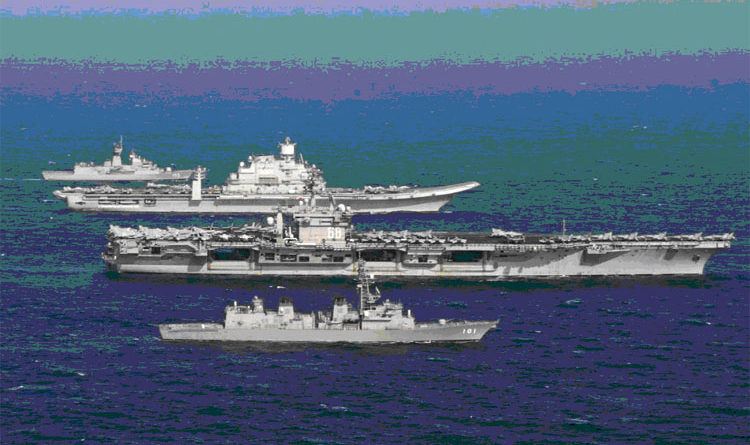Indian Navy Is Ready To Confront Chinese Challenge In The Indian Ocean Region
April 3, 2021
China’s growing presence in the Indian Ocean is forcing the Indian Navy to increase its maritime security activities in the region and partner with its allies. Maritime forces from the US, Japan, Australia and India during Malabar exercise in the Arabian Sea
The Indian Navy is ramping up exercises with the powerful navies of the US, France, and other countries to thwart any Chinese misadventure in IOR.
On March 28, India and the US conducted a two-day ‘PASSEX’ naval exercise in the eastern Indian Ocean region, signaling the growing congruence in their defense and security partnership.
While the Indian Navy was represented by its warship Shivalik and long-range maritime patrol aircraft P8I, the US Navy deployed the USS Theodore Roosevelt carrier strike group.
“In a first, enhancing jointmanship, Indian Air Force fighters were also included in the exercise affording the IAF an opportunity to practice air interception and air defense with the U.S. Navy,” the Indian Navy said.
The exercises were held a week after US Defense Secretary Lloyd Austin visited India, affirming President Biden’s strong commitment to its relations with its close allies and partners in the Indo-Pacific region.
The visit saw the two nations committing to consolidate their robust defense cooperation through deeper military-to-military engagement with Austin saying elevating the Indo-US friendship was the top priority for the Biden administration.
According to the Indian Navy, the exercise was aimed at “consolidating the synergy and interoperability achieved during the Malabar exercise that took place in November last”.
On March 30, a French naval delegation led by Rear Admiral Jacques Fayard, the French Joint Forces Commander in the Indian Ocean, met Vice-Admiral Hari Kumar, the Flag Officer Commanding-in-Chief, Western Naval Command.
The interaction involved the talk on “growing cooperation between both the navies on maritime issues and enhanced inter-operability for focused maritime security in the Indian Ocean region were discussed,” the Navy said in a statement.
India and France are about to embark on the annual bilateral exercise ‘Varuna’ between the Indian Navy and French Navy’s Carrier Strike Group in April.
The French Navy will for the first time be conducting a joint drill with all four members of the Quad – India, Australia, Japan, and the US – in the Bay of Bengal in the first week of April.
In January and February this year, the Indian Navy also conducted its largest combat exercise ‘Tropex’ which reviewed the operational readiness and capability of the Navy in the Indian Ocean. The month-long exercises witnessed joint drills by ships and aircraft and other assets of the Indian Air Force, Army, and the Indian Coast Guard in the Indian Ocean.
The Indian Navy increased the pace of its exercises with the foreign navies since January last year in a show of deterrence in the Indian Ocean.
The series of exercises started with the two ships from the Royal Navy of Oman arriving in Goa for ‘Naseem-Al-Bahr’ in which multiple assets of the Indian Navy were deployed. The COVID-19 pandemic halted all the war games in the IOR, until September 2020 when they were again resumed.
The Indian Navy has since been busy with bilateral and multi-lateral exercises involving powerful navies, most significant of which were the QUAD nations. As China kept increasing its assets in the IOR over the past decade, and it was during 2008-09 when the country’s Navy entered the region for the first time on an anti-piracy mission. Since then, it never left.
While the exercises are useful for interoperability for forces aiming for a common war, they may not be the ultimate solution, the experts say. Exercises are meant to enhance the mutual understanding of each other’s operational methods and best practices, channeling them into forming cohesive joint operations against a common enemy.
China is signing major partnerships with countries in Africa, and the latest with Iran, which signifies greater PLA Navy presence in the waters of the IOR in the coming years. The country is aiming to emerge as a key player in the Indian Ocean region, experts say, and not just confront India’s strategic role in the region.
The PLA Navy is growing in strength and the number of assets and will be a formidable force in the future.
Among many concerns about the Chinese incursion in the Indian Ocean, its fishing boats and research vessels are often spotted in India’s Exclusive Economic Zone (EEZ). China’s Yuan Wang class research vessel was spotted in the Indian Ocean during August 2020, in the backdrop of tensions in Ladakh where both the countries were engaged in a stand-off.
According to the Indian Navy, there were “four to six Chinese research vessels known to be presently operating in the IOR5.” These vessels were reportedly used to survey the ocean floor for the subsequent operation of the submarines.
China supplies naval assets to India’s neighbors, including Bangladesh, Sri Lanka, and Pakistan, and is becoming a major defense partner of most of India’s neighbors.
These concerns have brought the QUAD nations together while forging unprecedented military partnerships to challenge China, which is violating the territorial integrity of a number of nations in the IOR. The US-led QUAD has even made its anti-China ambitions public, pledging to get more countries into the fold.
However, experts say that the Indian Navy needs more budget to expand its reach in the IOR and bring in more assets to enable surveillance over a major part of the Indian Ocean. The force will have to work to match its capabilities with China’s PLA Navy if it aims to contain the threat in the future.
Courtesy: Eurasian Times

